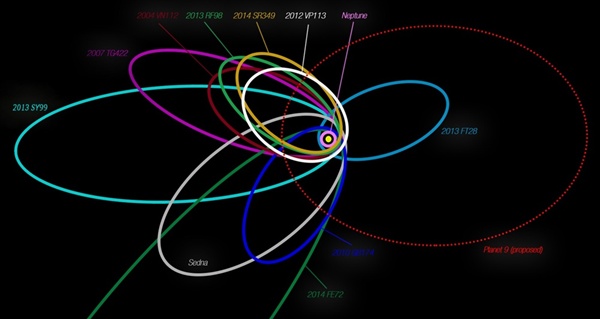Planet Nine may be a black hole the size of a baseball – Astronomy Magazine
In recent years, astronomers have discovered a number of far-flung objects that all have very similar perihelia, meaning they make their closest approaches to the Sun at about the same location in space. One leading theory that attempts to explain the clustering is that a massive and unseen world known as Planet Nine is hiding in the outer solar system.
Fauxtoez/Wikimedia Commons
The black hole hypothesis
But according to new research posted September 24 on the preprint site arXiv, Planet Nine isn’t the only possible explanation for the eTNOs. The culprit, the new study claims, could be a primordial black hole instead. Primordial black holes are predicted to have popped into existence within the first few fractions of a second after the Big Bang. However, their existence has never been confirmed.
If true, the proposed black hole likewise would be located hundreds of times farther from the Sun than Earth. But because black holes are incredibly adept at crushing down matter, if the black hole were about five Earth-masses, it would be only about the size of a baseball.
The primary reason the researchers say Planet Nine may instead be a black hole comes from a set of gravitational anomalies recently identified by the Optical Gravitational Lensing Experiment (OGLE).
As part of the OGLE project, astronomers monitored the sky in search of gravitational microlensing events, which occur when a massive foreground object (such as a black hole) passes directly in front of a background object (such as a star). If the alignment of the objects is perfect, the heavy foreground object acts as a lens of sorts, distorting and amplifying the light from the object behind it.
Based on five years of OGLE observations, researchers uncovered six strange microlensing events that seem to have occurred when objects roughly 0.5 to 20 times the mass of Earth acted as gravitational lenses. According to the paper, these objects, located about 26,000 light-years away toward the Milky Way’s galactic bulge, could just as easily correspond to an unexpected population of primordial black holes rather than free-floating planets.
“Capture of a free-floating planet is a leading explanation for the origin of Planet [Nine],” wrote the authors of the new study, “and we show that the probability of capturing a [primordial black hole] instead is comparable.”
If such a black hole, rather than a rogue planet, were captured by the Sun and is now roaming the outer solar system, than it would influence the orbits of eTNOs in the exact same way as Planet Nine.
According to Konstantin Batygin — who has been instrumental to the Planet Nine hypothesis but was not involved in the new study — it’s definitely possible that a primordial black hole could replace Planet Nine in their model, but that doesn’t mean they should.
“The important thing to understand here is that all that the calculations can tell is the mass of Planet Nine, not its composition,” Batygin told Astronomy. “So, in principle, Planet Nine can be a planet, a potato, a black hole, a hamburger, etc., as long as its orbital parameters are right.”
Though Batygin isn’t entirely convinced a black hole roaming the outer solar system would be a more natural fit than Planet Nine, he admits he’s hesitant to write the new theory off completely.
Or as he put it: “I always like to keep an open mind.”






